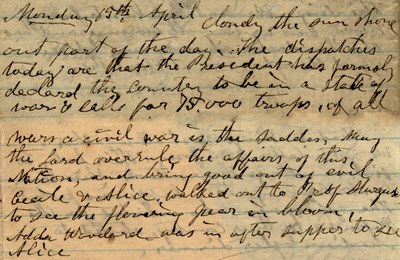
Plan your visit
After the Shots
April 12, 2017

On April 12, 1861, the first shots of the Civil War were fired at Fort Sumter in South Carolina a war that nearly divided this country forever. Battle names, places and dates are often what we think of: the First Battle of Bull Run in July 1861; Antietem in September 1862; Gettysburg in July 1863. Occasionally, we think of letters between soldiers and wives, mothers or sisters. These are all stories that relate to war in the midst of the action. But what were people thinking several states away from Fort Sumter in the days immediately following those fateful shots?
Marie Ester Brandt is someone you likely haven’t heard of. She lived with her family in Hanover, Indiana. She never married; she didn’t make a name for herself. She was a small-town woman who went to church, read books and looked after the home she shared with her mother and one of her sisters. She also kept a diary, writing 2,331 pages from 1849 to 1869 whether she wrote more after this is a mystery.

Three days after shots were fired at Fort Sumter, she wrote, “the dispatches today are that the President has formaly (sic) declared the country to be in a state of war and calls for 75,000 troops. Of all wars a civil war is the wors[t].” She hoped that good would come out of evil and that God would watch over the nation. The day after Marie wrote this diary entry, Gov. Oliver P. Morton formally called the people of Indiana to arms, resulting in more than three times the number of volunteers he requested.
Her diary entries over the next several years mention the war, but they rarely dwell on the carnage that was surely reported every day. Major news is often reported in the same line as who she sent a letter to that day or who in town is unwell.
Marie’s “Cronicle (sic) of events, for future refference (sic)” has certainly fulfilled its purpose. It shows how national news fit into everyday lives.
Find selections of Marie’s diaries here. For more information about Marie and her diaries, check out THG: Connections, Spring/Summer 2013 at the Basile History Market at the Eugene and Marilyn Glick Indiana History Center.
Read Governor Morton’s Call to Arms here.








